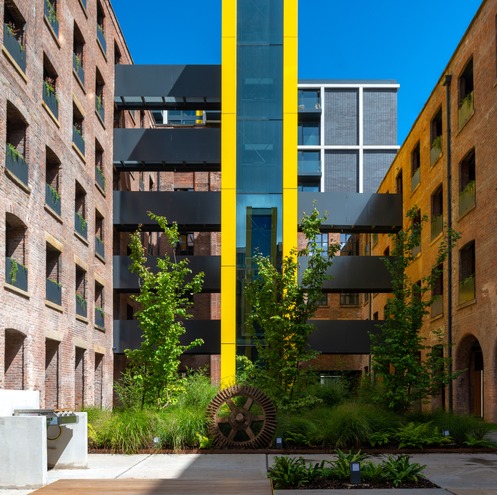Get updates from The Developer straight to your inbox Yes, please!
Crusader Works, Manchester – Capital & Centric with shedkm

Originally built in the late 1840s, Crusader was one of the earliest and largest purpose-built textile machinery works in Manchester. Retrofitted for a residential community, the project aimed to preserve historical features where possible and minimise interventions to the existing fabric, restoring the courtyard enclosure and masonry façade.
Who is on the project team?
Architect - shedkm
Engineer - Arup
Principal contractor - Capital & Centric
Services Engineer - Progressive Services Design Ltd
Describe the context of this project?
The transformation of Crusader Mill, one of Manchester’s most complete industrial mill complexes has been an ambitious example of conservation and re-use and has driven the regeneration of the Piccadilly-East neighbourhood, with new homes and workspaces popping up since. The vision of the project is to demonstrate a progressive approach to creative regeneration to deliver a unique residential community, with a range of apartment types and landscapes aligning with contemporary lifestyles.
Originally built in the late 1840s, Crusader was one of the earliest and largest purpose-built textile machinery works in Manchester. Following decades of use, a devasting fire and subsequent rebuilding, the complex continued to produce machinery until the 1920s, when the English textile industry went into terminal decline. The buildings were let to multiple small businesses thereafter, but survived remarkably intact throughout the 20th century, and was listed in 1994.
Tell us what you did and how the project enlivened the place?
The initial space planning studies looked to utilise all existing structures, however the opportunity to replace the unlisted warehouse with a more efficient new build gave a balance to the project appraisal which would facilitate the regeneration of the dilapidated listed buildings and make the overall scheme viable.
The special architectural interest of Crusader lies in the collection of buildings, its scale, industrial character and the aesthetic effect of the repetitious bays and windows. Our motivation was to celebrate these aspects and align heritage significance with a design strategy that cultivates residential community and creates a strong sense of home for residents.
The initial diagram placed two circulation cores within the courtyard, branching out to cloister walkways that sit behind the existing masonry facades – this simplicity of the diagram was carried through to the finished scheme. Locating the new cores within the courtyard rather than within the existing building generates increased net area, separates living accommodation from lifts and refuse stores and creates a clear circulation and servicing strategy.
The bold architectural interventions of the cores bring a new identity to the space, uniting the existing buildings around a communal landscaped courtyard and placing emphasis on the collective nature of a residential community.
Did the project make a positive social and environmental contribution?
Crusader was the first step in the regeneration of Piccadilly East neighbourhood. The challenge for the team was to create spaces where people were drawn to be part of a community in an area that was at the time rough around the edges. Capital & Centric showed that Piccadilly East was the place to be and a lot of that was down to the architectural appeal of the design and the respect it showed the industrial nature of the area.
The impact of the project is far-reaching in showing the environmental impact of re-purposing buildings (converting the mill buildings has saved over 2,400 tonnes of embodied carbon) and the social importance of maintaining the cultural heritage of a city.
The project manages to retain a large extent of existing building whilst being architecturally bold. It was designed from the outset with full lifecycle cost in mind. The integration of existing fabric elements led the material language, with robust, hardwearing materials adopted throughout, thus contributing to the reduction of maintenance and energy use in upkeep.
The success of Crusader has been critical in transforming the area. It’s now one of a cluster of buildings in the emerging Piccadilly East neighbourhood. Capital & Centric’s ethos was to create a community and facilitate this in its early stages of establishing itself. The scheme is entirely owner-occupied, and other Capital & Centric residential developments in the area can use the courtyard, extending a sense of place and community to the wider neighbourhood.
Sign up to our newsletter
Get updates from The Developer straight to your inbox
Thanks to our organisation members
© Festival of Place - Tweak Ltd., 124 City Road, London, EC1V 2NX. Tel: 020 3326 7238